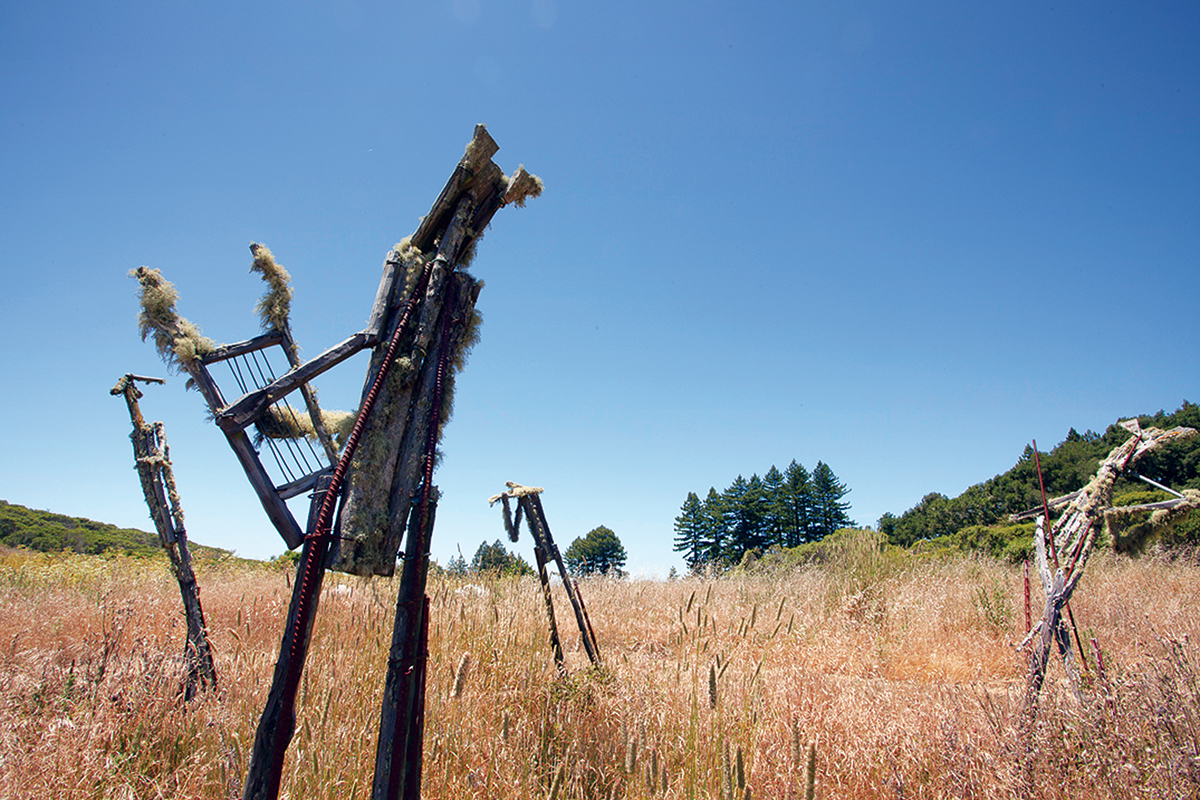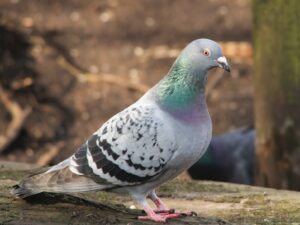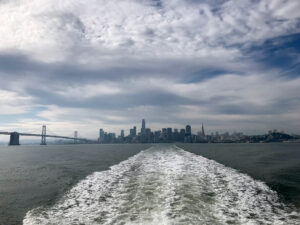In 1999 an artist named William King gathered a collection of old fence posts on a windswept hilltop in Woodside and fashioned them into sculptures—four human-size, instrument-holding creatures. He called the quartet “Orpheus Coyote and Friends,” after the largest of the sculptures, a coyote playing what appears to be a flute. Since then moss and lichen have grown over the sculptures, but when the wind picks up—as it often does there—the metal instruments in their hands resonate, creating an odd, metallic music that echoes down the valley below.
In the fall and winter, dry grass sways around the band, seemingly joining in the dance. It’s hard not to get swept away by it. Their wind-created music captures the intermingling of nature and art that is at the core of the Djerassi Resident Artists Program.
“We like to think of landscape as an extension of their studio,” says Felicia Herron, the environmental stewardship associate for the program and my tour guide for a day of exploring the 583-acre property in the San Mateo County hills where the resident artists stay and create their works. There are more than 70 sculptures at Djerassi, most of them pieces made specifically for the place and scattered among creeks, redwood groves, grasslands, and ancient oaks.
Remember, they are an exotic species in the Western United States, and are rapidly increasing their geographic range and range of habitats. Are they outcompeting or excluding native species in the process? How would we know? We have done almost nothing to monitor changes in the assemblage of mushroom species in areas before and and after the incursion of death caps.
Further Reading
Pringle et al, “The ectomycorrhizal fungus Amanita phalloides was introduced and is expanding its range on the west coast of North America,” Molecular Biology 2009
Lockhart et al, “Simultaneous emergence of multidrug-resistant Candida auris on 3 continents confirmed by whole-genome sequencing and epidemiological analyses,” Clinical Infectious Diseases 2017
Battalani et al, “Aflatoxin B1 contamination in maize in Europe increases due to climate change,” Scientific Reports 2016
HIKING IN DJERASSI
The program hosts roughly 26 guided sculpture hikes a year for groups of 20 to 25 people, including free public hikes, director’s hikes, and the newly created “Everything Hikes.” But getting a spot can be tough; Djerassi limits its public hikes so as not to disturb the artists. Last year’s registration for free hikes filled up six minutes after it was announced. Visit: djerassi.org/events/sculpture-hikes
A 2-mile loop trail, accessible to the public during an annual open house or by guided hike, winds past the work created by roughly 30 artists over the last several decades. Other guided hikes cover almost all of the 5.5 miles of trail and nearly every sculpture on the property.
The drive to Djerassi takes you up over foggy hills, along Skyline Boulevard, and through wooded canyons infused with soft, warm light. The smell of fir and bay laurel trees and the quiet chatter of birds fill the air as Herron orients me to the land.
The selective residency hosts more than 70 artists a year in various disciplines—choreography, musical composition, writing, visual art, and science—for a monthlong stay, during which they can create, lose themselves in the landscape, or simply sit and let inspiration roll in like mist over the hills.

Carl Djerassi was a scientist, artist, poet, novelist, and playwright, but he may be best remembered as the man who helped invent the birth control pill in the 1950s. Money from the invention allowed him to purchase property west of Skyline Boulevard, and over the years he turned it into a substantial Shorthorn purebred cattle ranch. Djerassi built a house on the land, as did his daughter, Pamela, and son, Dale. Pamela, an artist and poet, lived there with her husband.
Tragically, in 1978, when Pamela was just 28, she took her own life. To honor his daughter’s work, Carl created a small family foundation and started the residency program. The first artist invited to live and work on the family’s land for a year was Israeli artist Tamara Rikman, who began her residency in 1979; three other female artists followed. But the fourth commented she sometimes felt isolated there.
“That struck a chord with everyone with respect to my sister, who was alone there a lot,” says Dale Djerassi, a founding trustee of the program.
And so in 1983 the program expanded—the old cattle barns and ranch manager’s house were renovated into artist studios—to welcome larger coed groups of artists.
“That my father could have the vision to create something like that out of something so tragic is of great personal meaning to me and the legacy of my sister,” Dale Djerassi says. “This is not a monument; it is a living, breathing, dynamic institution.”
To date, 2,400 artists from more than 50 countries have wandered these rolling hills, and the sculpture collection has grown, some pieces made by the program’s artists, others commissioned.
Even nonvisual artists such as writers, poets, and composers are encouraged to create physical pieces for display here. On the 2-mile hike you can see three of writer Cintia Santana’s poems brought to life on signs placed at the bases of redwoods. These “Footnotes” draw attention to the trees, encouraging the reader to consider them in the context of the landscape.
In 1999, the Djerassi family’s foundation donated half of the ranch’s 1,300 acres, including Pamela’s interest in the property, to the newly formed nonprofit Djerassi Resident Artists Program. That gift created the largest artist residency on the West Coast. A conservation easement with the Peninsula Open Space Trust protects the program’s land from development, preserves its conservation value, and ensures it is open to the public on a limited basis.
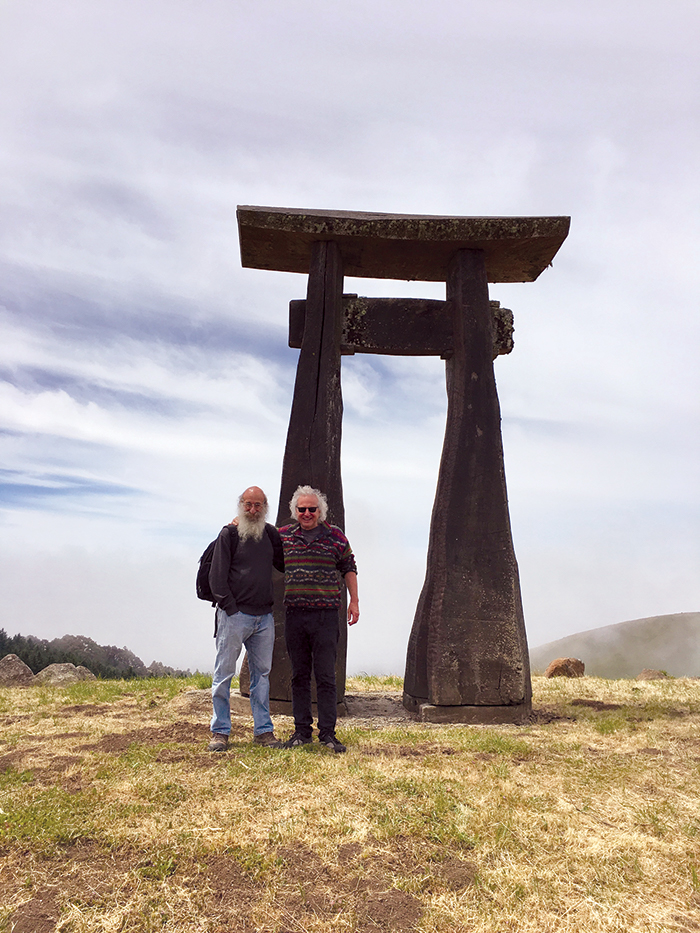
As Herron and I climb from the wooded parking area to the top of the property, oak woodland gives way to clear blue skies. Raptors circle overhead near “Torii,” a 17-foot-tall structure, carved from a single chunk of reclaimed old-growth redwood, that resembles a larger-than-life pi symbol. In Japan, torii, which translates to “bird abode” or “bird gate,” is a gate marking the entrance to Shinto shrines, signifying the transition to the sacred world.
Lichen decorates one side of “Torii,” made by Sonoma-based artist Bruce Johnson in 1983. The sculpture’s weathered wood frames a ridgeline of undulating hills and, far below, the shoreline and breaking waves of San Gregorio State Beach. With its location at the top of the property and prominence on the skyline, “Torii” has become the symbol of Djerassi.
Next we descend into the heart of the property, where the artist’s studios look over the valley, and then we wander farther into the wild fringes. The trail meanders through shady redwood forests, oak woodland, and madrones, past grasslands and sun-baked chaparral. Paola Cabal, a former resident, used to walk this path often.
“It’s a space that really filters into your subconscious and becomes part of your dreams,” Cabal says. “I can’t think of any other residency that has the same insane beautiful acreage to just get lost in.”
In a redwood grove we come to a large stump nestled among its towering relatives. Alyssa Neglia made “Roots to Crown” in 2006 by upholstering the redwood stump—the remains of a logging victim—in dark red vinyl, covering it from cushiony seat to the contours of its twisting root system. As filtered light falls on the forest floor, the stump takes on a sacred quality.
“It takes something that is sad and makes it beautiful,” Herron says.
We weave through chaparral and then back into another redwood grove, where Herron points out a healthy understory of sword fern and false Solomon’s seal. “Nest,” created by Cynthia Harper in 1997 from madrone and redwood branches, rests among the plants. Several feet high when first created, the sculpture was held together by wooden dowels that are now coming apart, and the piece is collapsing. Perhaps—as Harper had hoped—birds or other animals have carried off some sticks to use in their own nests.
Artists who choose to create a sculpture at Djerassi are encouraged to make their pieces from natural materials that fit into the landscape and will eventually degrade and return to it. Unlike museums and collecting institutions that take extreme measures to preserve art, Djerassi embraces the natural decay of its works as a way of honoring the land’s natural heritage.

As we leave the redwood forest, Herron leads the way through golden grass. The Djerassi property spans roughly 128 acres of grassland, home to rodents and prowling bobcats, and includes rare coastal prairie grasslands that support a rich diversity of wildflowers.
Herron, who leads Djerassi’s environmental stewardship volunteer program, organized a first-ever bioblitz on the property in July 2017. Volunteers documented more than 30 species of plants and animals in iNaturalist, including the Acmon blue butterfly, skunkweed, a waxcap mushroom, and a pygmy nuthatch.
Beyond the prairie’s whispering grass lie patches of scrubby coyote bush. On sunset hikes you can listen to coyotes yip and the birds perform their evening chorus through a wooden megaphone constructed from old fence boards. “Hear,” made by Aristotle Georgiades in 2013, is also for yelling into, creating a wave of echoes in the valley.
Cool scented air greets you as you descend into a grove of redwoods where Harrington Creek follows its course. Harrington Creek is a major tributary in the San Gregorio Creek watershed, which environmental groups and state and federal agencies have targeted as a place to bring back coho salmon. “What we do on our property can affect the health of this important watershed,” Herron says. She is happy to see redwood sorrel and leopard lily—indicators of healthy redwood forest—growing on the forest floor.
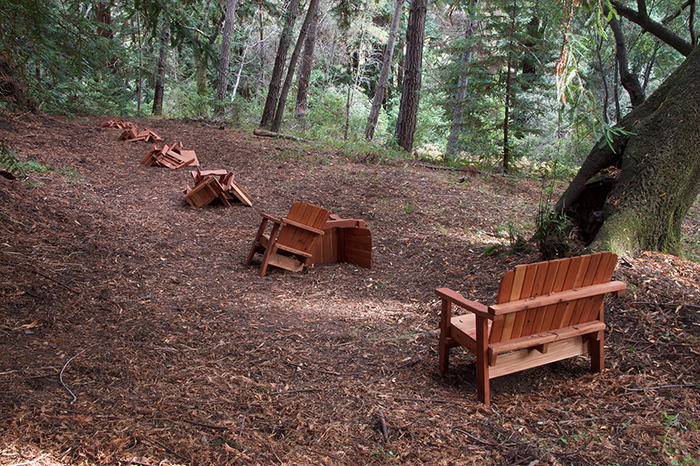
“Droog,” a word that means friendship in Russian, recalls a time when this forest wasn’t quite as intact. To create the piece, artist Blane de St. Croix started with a charred redwood stump, another relic of former logging operations, and added two pairs of burnt pine legs, emulating the stance of 19th-century loggers when using a two-man saw.
Though it evokes loss, it’s one of Herron’s favorite pieces here. “To look at the charred, artistic representations of the legs, of the mysterious men who once stood in that same position and worked together to fell such a huge tree, is really beautiful and eye-opening for me,” she says. “It helps paint a picture of what this place looked like only 100 or so years ago; along with all that destruction there is now beauty, after years of healing.”
Herron says the felled tree likely shot up new sprouts, which grew into the giant trees we see all around “Droog.”
Longtime volunteer docent Dennis Ruby leads artist orientation hikes, private hikes, and a new offering he created in 2017 called the “Everything Hike” at Djerassi. The latter covers almost all the sculptures on the property, but since it’s six hours long Ruby wasn’t sure it would be popular. But all five of the Everything Hikes sold out almost immediately. For 2018 he is stepping it up to nine.
Ruby’s love of Djerassi goes way back. A veteran docent in nearby parks, he came here with his wife on a public hike in 2008 and loved it, so when the docent program began in 2012 he signed up immediately. “The natural beauty of the Djerassi Ranch is captivating,” he says.
A tour with Ruby is one way to see what is perhaps the most unusual piece on the property. The “scultura interventa,” or intervening sculpture, completed in 1989 by Italian artist Mauro Staccioli, consists of six giant plywood and stucco geometric shapes in an oak tree grove.
Although they appear opposed to the natural environment, their extraordinary size makes the ancient oaks around them that much more noticeable. “That is the nature of Staccioli’s art,” Ruby says. “He feels as we walk through the environment, whether we live in a forest or in a city, we tend to walk through those environments without really noticing what’s going on in them.”
The grove makes you stop in your tracks. Some of the pieces lean against the oaks for support. When the trees die the statues will fall. But for now ribbons of light stream over their gray surfaces. All is quiet except for the distant drilling of a woodpecker. It’s a surreal feeling to see human-made objects left to weather and age with the elements, to crack and fall and return to nature in real time. They appear at once so giant and so fragile, so inseparable from the trees.

